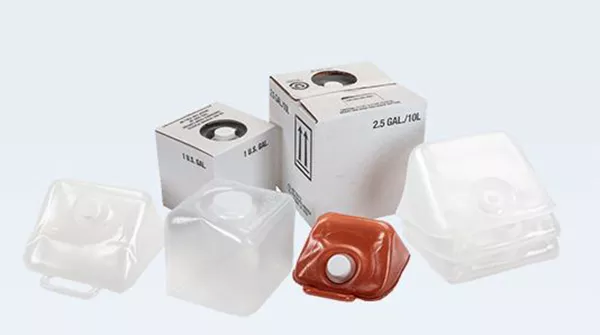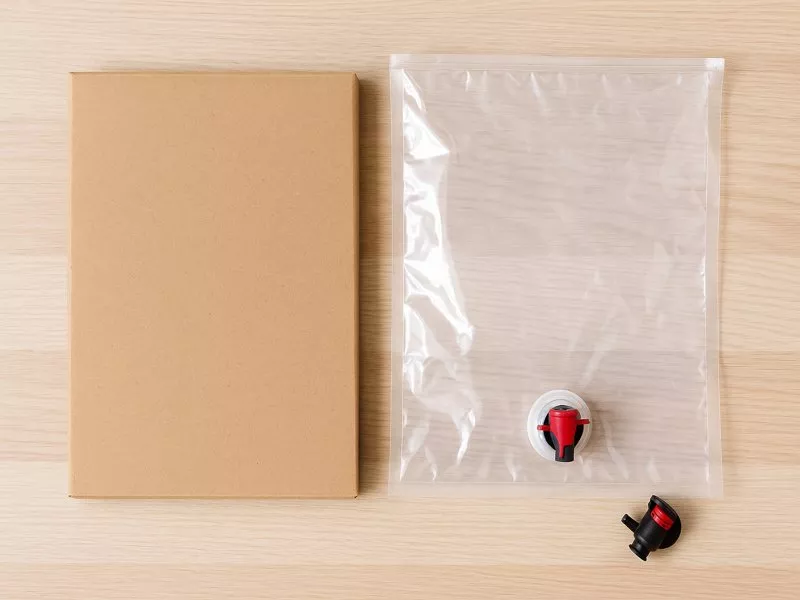Bag-in-Box (BiB) packaging—an inner plastic bag with a tap, housed inside a cardboard carton—shines for freshness, storage efficiency, and waste reduction per serving. But when the party’s over, many people wonder: how do I recycle this correctly? Because BiB is a combination pack (paperboard + multilayer plastic + small rigid parts), the right end-of-life path depends on separating components and following local rules.
This guide walks you through everything: what each part is made of, how to prep and sort it, regional differences, business-scale options, and even practical reuse ideas when recycling isn’t available.
What’s in a Bag-in-Box?
Outer carton: Corrugated or paperboard. Usually curbside-recyclable with cardboard.
- Inner bag: Typically polyethylene (PE) layers plus an oxygen-barrier layer (often EVOH or nylon) and sometimes a thin metallized layer. Because of these multilayers, many municipal programs do not accept the bag in curbside recycling.
- Tap/fitment/cap: Usually polypropylene (PP) or high-density polyethylene (HDPE) plus small elastomer parts. Because the piece is small and mixed-material, curbside acceptance varies widely.
Key takeaway: The carton is almost always recyclable. The bag and tap require extra steps or special programs—or, where allowed, thoughtful reuse.
Quick Decision Table
| Component | Typical Material | Can I put it in curbside recycling?* | Alternatives |
| Outer carton | Paperboard/corrugated | Yes (flatten, keep dry) | Compost (if plain, no heavy coatings) |
| Inner bag | Multilayer PE + barrier | Usually No | Store drop-off only if labeled clean PE film; otherwise, mail-back/specialty programs or landfill |
| Tap/fitment | PP or LDPE + elastomer | Often No (too small/mixed) | Local hard-to-recycle center, mail-back, or reuse |

Step-by-Step: Household Recycling
Step 1 — Empty the pack completely
- Dispense until the flow stops.
- Remove the tap (details below) and squeeze remaining liquid into your sink (use a strainer if there’s pulp).
- For sugary/acidic drinks, a quick rinse prevents odors and pests. Do not pour sticky liquids into storm drains.
Step 2 — Separate the components
- Open the perforated panel on the carton and gently pull the bag/tap assembly out.
- Detach the tap from the bag: most taps twist out with a quarter-turn; others pull straight. Work over a towel to catch drips.
Step 3 — Recycle the carton
- Flatten the box.
- Remove plastic films or non-paper sleeves (if present).
- Place with cardboard/paper; keep it dry to avoid contamination.
Step 4 — Prepare the inner bag
Check symbols/labels. If the bag explicitly says “PE film—store drop-off OK” (or has a How2Recycle “Store Drop-Off” mark), you can clean and return it with grocery bags to participating bins.
If there’s no clear label, or it references nylon/EVOH/metallized layers (common for wine and juices), assume not store-drop-off eligible.
If eligible:
- Slice one corner with scissors.
- Rinse with a small amount of warm water.
- Drain and air-dry fully (moist film isn’t accepted).
- Bundle with other clean films for store drop-off.
If not eligible: consider mail-back programs (brand/manufacturer, TerraCycle-type services, or local hard-to-recycle events). If none exist, dispose in trash—never in curbside recycling (it tangles sorting equipment).
Step 5 — Handle the tap/fitment
If your city accepts small rigid plastics (PP #5 or HDPE #2) and lists “caps & small items accepted”, you may include the tap inside a larger same-material container (e.g., drop the PP tap into an empty, rinsed PP tub with the lid screwed on). Many facilities don’t allow this—check local rules.
Otherwise:
- Save taps for hard-to-recycle events.
- Reuse (see ideas below).
- As a last resort, put it in the trash to avoid contaminating recycling.
Step 6 — Labels, adhesives, and sleeves
- Paper labels on the carton are fine.
- Plastic windows or glossy sleeves should be removed and landfilled unless they’re labeled recyclable.
Step 7 — Log your system
If you regularly use BiB (cold brew, post-mix soda, wine), create a small household workflow:
- A “flat & stack” spot for cartons.
- A drying rack for eligible film.
- A jar for small plastic taps/parts destined for hard-to-recycle drop-offs.
Step-by-Step: Foodservice or Office Recycling
For cafés, offices, caterers, and venues using multiple BiBs per week, a bit of structure goes a long way.
- Set clear stations: “Flattened OCC” (cardboard), “Rinse & Dry Film,” “Taps/Small Plastics.”
- Train staff: Show how to remove taps, slit and rinse bags, and keep film dry for store drop-off or vendor collection.
Consolidate:
- Bale or bundle cartons with OCC.
- Collect film in clear liners labeled “Clean PE Film Only.”
- Store taps in a sealed container for periodic drop-off.
Work with suppliers: Ask your beverage distributor about take-back options for film and fitments; some provide closed-loop recovery.
Track diversion: Record monthly counts (cartons recycled, film returned) to quantify waste reduction for sustainability reporting.
Special Notes by Materia
1) The Outer Carton (Paperboard/Corrugated)
- Do: Keep it dry, flatten, and include it with cardboard.
- Don’t: Put waxed or heavily food-soiled boxes in paper recycling (small stains are okay; soaked/greasy is not).
- Tip: If your community accepts food-soiled paper in compost, that’s an option for lightly soiled cartons (no plastic liners).
2) The Inner Bag (Multilayer Film)
- Why it’s tricky: Oxygen-barrier layers (EVOH/nylon) and metallization are great for freshness but complicate recycling.
- When store drop-off works: Only for clean, dry, single-resin PE films. Some BiB liners (especially for water) are PE-only; many for wine/juice are not.
- Best practice: Follow the on-pack label or supplier specs. If unknown, do not put into curbside recycling; use mail-back or trash as a last resort.
3) The Tap/Fitment (PP/HDPE + Elastomer)
- Too small: Many MRFs screen out items under ~2 inches.
- Mixed parts: Elastomer seals and springs complicate recycling.
- Workarounds: Hard-to-recycle drop-offs; place inside a larger container if your program allows, or reuse.

Reuse Ideas (When Recycling Isn’t Available)
For the bag (non-food reuse only, after thorough cleaning):
- Camping water bag (label clearly “non-potable” if you’re unsure about cleanliness).
- Ice-pack substitute: Partially fill with water, freeze flat for coolers.
- Tool/paint wash bag for DIY projects, then dispose.
For the tap:
- Garden drip for slow watering of potted plants (attach to a small reservoir).
- Shop liquid dispenser (detergent, window cleaner) from a repurposed jug.
- Classroom/DIY projects (valves for maker builds).
For the carton:
- Storage (cables, craft supplies).
- Shipping small items after reinforcement.
- Kindling if local rules permit burning (outdoor fire pits, where legal).
Food-contact reuse is only recommended if you can confidently sanitize and confirm material compatibility. When in doubt, non-food reuse is safer.
Regional Tips & What to Ask Locally
- Curbside rules: Search your city’s recycling page for “plastic film,” “caps & lids,” and “small plastics.”
- Store drop-off: Many supermarkets accept clean PE film (bags, wraps). Confirm whether they accept “non-retail film” like liners.
- Hard-to-recycle centers: Some counties run quarterly events for mixed plastics.
- Mail-back: Look for manufacturer programs or third-party services for multilayer films.
- Commercial accounts: Ask OCC haulers about film add-ons; some consolidate PE film from business clients.
For Brands and Buyers: How to Choose a More Recyclable BiB
- Mono-material PE liners with clear Store Drop-Off labeling.
- Taps and caps made from a single resin (e.g., PP) and sized to meet local acceptance criteria, or supported by a take-back program.
- Minimal inks and coatings on cartons; use water-based adhesives.
- On-pack instructions: Place a clear How2Recycle or equivalent label.
- Supplier partnerships: Offer business clients collection and consolidation for film and tapes.
Sample Workflow You Can Post Near Your Bin
- Empty the box completely.
- Remove the tap and separate the bag from the carton.
- Flatten the carton → Recycling (Cardboard).
Check the bag label:
- If “Store Drop-Off / PE film”: Rinse, dry, bundle, take to store.
- If no label or metallized/barrier: Trash (or use mail-back).
Tap: If your city accepts small rigid plastics in a closed container, include it; otherwise, hard-to-recycle drop-off or reuse.
Why Doing This Right Matters
- Keeps recycling streams clean: Film and tiny parts jam sorting equipment or get screened out as residue when placed curbside.
- Improves true recycling rates: Clean cardboard is valuable; keeping it dry and separate boosts recovery.
- Signals demand: Using store drop-off, mail-back, and asking suppliers for take-back programs encourages better, more recyclable designs.
The Bottom Line
Recycling a Bag-in-Box is simple once you know the drill:
- Carton: Flatten and recycle curbside.
- Bag: recycle only if clearly labeled PE via store drop-off; otherwise, mail-back or landfill.
- Tap: check local rules for small rigid plastics; if not accepted, save for hard-to-recycle events or reuse.
With those steps, you’ll keep valuable cardboard in the circular economy, avoid contaminating curbside bins with hard-to-process films, and—where possible—give the plastic components a second life through specialty channels. If you use Bib regularly at home or work, set up a small station and routine. The planet (and your waste bill) will thank you.
